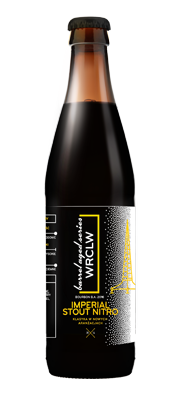The strongest and thickest beer in the offer of Browar Stu Mostów. Black, non-transparent, brewed with a huge amount of dark and roasted malts. Filled with chocolate, coffee and caramel aromas, with time the beer releases dark dry fruit and pumpernickel notes. The richness of the beer has been intensified by ageing in Bourbon Woodford Reserve barrels that have brought about the aromas of vanilla, coconut, spices, and of course American whiskey. This is the first in Poland nitrogen-infused Imperial Stout – with a thick head and unique texture. Exceptionally aromatic and savoury.
 |
 |
WRCLW Imperial Stout NITRO Bourbon B.A. 2018The strongest and thickest beer in the offer of Browar Stu Mostów. Black, non-transparent, brewed with a huge amount of dark and roasted malts. |
Style
One of the strongest styles in the world– Imperial Stout (Russian Imperial Stout). The origins of this historic beer date back to the turn of the 18th century and beginning of the 19 th century when London-based breweries started brewing this style. Imperial Stout was created for exactly the same reasons as today’s new wave styles: to meet the needs of consumers looking for new quality beers, specifically full-flavoured and full-bodied ones. With time, the style gained so much recognition all over Europe that it started to be exported to Sankt Petersburg. It wasn’t, however, until the 20th century that the beer gained its name of the Russian Imperial Stout. As the “Imperial” part of its name suggests, this is one of the strongest beers high in extract. Although it is brewed in many versions, it is the extreme version of this style high in extract that makes the hearts of any beer lovers beat faster. It is not an ordinary beer! It is a great event to have such a powerful beer to be brewed.
Malts/extract:
It’s quite a challenge to produce such high extract. Taking into consideration thickness of the wort (30% extract) the efficiency of the production process slows down. Both the abilities of brewers and capacities of the equipment are tested. It’s nothing but extreme: the total amount of malts, the mix of dark and caramel malts and roasted and colouring malts, which bring about intense coffee, caramel, and freshly roasted cocoa beans. The wort itself tastes like sweet chocolate-coated brownie. It’s an amazing process to observe.
Hops:
Traditional, continental hops have been used to produce required bitterness level (Magnum) and to release herbal aromas (Tettnanger) which with time wonderfully oxidize in dark strong beers. Imperial Stout shifts a bit towards the malty side and this is the reason for low intensity hopping.
Ageing in Bourbon barrels:
Beer ageing is a fascinating process, which is being studied by scientists. During the aging process beer oxidizes: taste and aroma balance, tones of port wine, sherry, dry fruit (plums, raisins, cherries) appear. Alcohol tones soften while wood releases:
– tannins – defined as the taste of the wood that introduces a unique astringency to balance the beer’s sweetness
– caramels and Maillard reaction compounds that are produced while smoking barrels (they produce the characteristic colour of Bourbon)
– Lignins finally transform into vanilins and gives the beer its characteristic vanilla flavours; American oak produces a group of phenols which account for spicy aromas: cloves, cinnamon, coconut and smoky tones.
Finally, as the beer matures in the barrel, which is not a tight container, water evaporates more quickly than other ingredients. This effect is known as the “angel’s share.”
Barrel-aged beers absorb the qualities of the alcohol previously stored in the barrels. Bourbon Woodford Reserve barrels account for the beer’s deep aroma of vanilla, coconut and caramel as well as spicy flavours.
Taking everything into consideration, the complexities and multiple layers of this beer style can be savoured in various temperatures. We recommend serving it in a slightly lower temperature of about 10°C and warming it up in your palms up to about 18°C.
Nitrogen-infused beers:
Nitrogen’s ability to dissolve in liquids is several times lower than that of carbon dioxide.
What we have used at Browar Stu Mostów is advanced technological solutions that allow us to dissolve as much nitrogen as possible in beer. Right after opening and pouring the beer into a glass, nitrogen escapes as quickly as possible creating a cascade effect of a huge amount of tiny bubbles. After a while, nitrogen moves up whisking protein dissolved in beer. As a result of this process creamy and long-lasting beer head of tiny bubbles is produced, which is not available in carbonated beers.
To fully enjoy the nitro beer, serve it right:
- cool the bottle down to <7 ⁰C; don’t shake it
- open the bottle quickly and pour the beer into a glass holding the bottle vertically
- now you can enjoy the cascade effect, which produces a beautiful beer head of tiny bubbles.
This is the first in Poland nitrogen infused Imperial Stout aged in oak barrels. Nitrogen makes strong beers lighter and smoother. This style itself is unique for its thickness. For this reason, the cascade effect takes place as if in a slow motion. High thickness and stickiness make the bubbles to go up slowly. It is recommended to wait a bit longer before pouring the beer into a glass to give the nitrogen bubbles more time to act. It’s not a waste time. The process itself is very impressive!
- Style: Imperial Stout Barrel Aged NITRO
- Parameters
- Extract: 30,0%
- Alcohol: 11,0% obj.
- IBU: 62
- Ingredients:
- Malts: Pilsner, Munich II, chocolate wheat, caramel 150 EBC, roasted barley, colouring
- Hops:
- Bitter: Hallertau Magnum (DE),
- Aromatic: Tettnanger (DE)
- Yeasts: Danstar Nottingham
- Look: non-transparent black, dark brown thick head of tiny bubbles building the cascade effect
- Aromas: Bourbon, chocolate, coffee, vanilla, nuts, coconut, toffee, chocolate waffles, prunes, cherries, pralines
- Mouthfeel:
- thick, oily, velvety smooth
- bitter sweet chocolate
- Warming upon swallowing, slightly astringent finish (tannin) produced by wood
- Serving temperature: 12-17⁰C
- Glass: Tulip, Sniffter
- Foodpairing:
- Very intense and strong beer to be served with desserts only: tiramisu with forest fruit; Belgian bitter chocolate pralines

